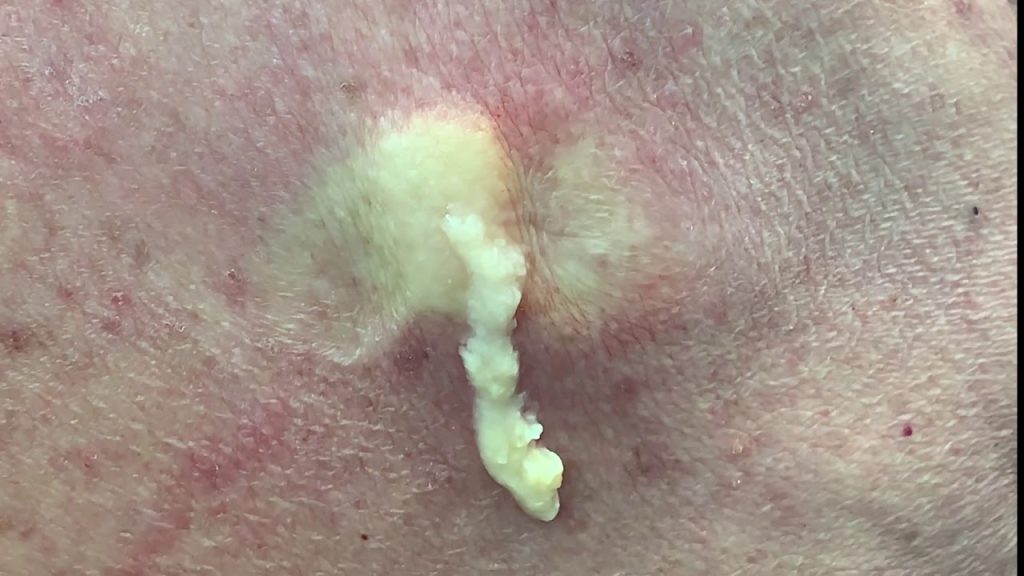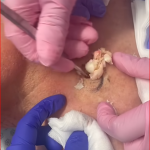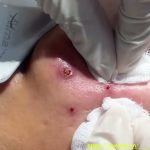-
Deep, painful cysts:
Cystic acne is characterized by deep, inflamed cysts that can be painful and cause scarring if not treated properly.
-
Infected blackheads:
A blackhead can evolve into a cyst if it becomes infected or inflamed.
-
Medical treatment:
Cystic acne requires medical treatment from a dermatologist, often involving antibiotics, topical creams, or even injections.
-
Importance of professional care:
Self-treating cystic acne can worsen the condition and increase the risk of scarring.
-
Plugged pores:
Blackheads are essentially plugged pores that appear dark due to the build-up of oil and dead skin cells.
-
Not always painful:
While they can be a cosmetic concern, blackheads are typically not painful.
-
Can be removed:
Blackheads can be removed by professional skin care experts or with proper tools.
-
Home care:
Gentle home care, like using salicylic acid or retinoids, can help prevent blackheads, but deep-seated blackheads might require professional extraction.
-
Progression:
A blackhead can sometimes progress into a cyst, especially if it becomes infected and inflamed.
-
Treatment:
While blackheads can be treated independently, cystic acne requires a different approach due to the deeper nature of the cysts.
-
Importance of professional advice:It’s important to consult a dermatologist for proper diagnosis and treatment of both blackheads and cysts.
Removing a blackhead cyst—also known as an epidermoid cyst or sebaceous cyst—requires more care than removing regular blackheads. These cysts are deeper, often larger, and contain trapped keratin (not just oil), sometimes with a visible blackhead (central pore). Here’s how to safely manage and treat one:
⚠️ IMPORTANT: Don’t Try to Pop It Yourself
Unlike regular blackheads, blackhead cysts can’t be squeezed out safely at home. Trying to pop it can:
-
Cause infection
-
Lead to scarring
-
Push contents deeper into the skin
✅ Safe Options to Treat or Remove a Blackhead Cyst
1. Warm Compress (Temporary Relief)
-
Soak a clean cloth in warm water and apply it to the cyst for 15–20 minutes, 2–3 times daily.
-
Helps soften the skin and may promote drainage if the cyst is inflamed.
-
This does not remove the cyst but can reduce swelling or tenderness.
2. Topical Treatments (Limited Effectiveness)
Over-the-counter creams may help reduce inflammation but won’t eliminate the cyst:
-
Benzoyl peroxide or salicylic acid: May help if there’s minor infection or clogged pores around the cyst.
-
Retinoids (like adapalene): Can reduce keratin buildup over time, but results vary.
These treatments are best for preventing new cysts, not removing existing ones.
🧑⚕️ Professional Medical Treatment
For permanent and safe removal, see a dermatologist. They will assess and use one of the following:
🔹 A. Incision and Drainage (I&D)
-
Performed when the cyst is inflamed or infected.
-
A small cut is made to drain pus and keratin.
-
Does not remove the cyst sac, so it may return.
🔹 B. Surgical Removal (Excision)
-
Best for long-term removal.
-
The entire cyst sac is removed to prevent recurrence.
-
Usually done with local anesthesia.
-
Minimal scarring if done properly.
✅ Recommended if the cyst is growing, painful, or keeps coming back.
🔹 C. Steroid Injection
-
If the cyst is inflamed but not infected, a corticosteroid injection can reduce swelling and tenderness quickly.
🧴 Aftercare (Post-Treatment)
-
Keep the area clean and dry.
-
Avoid heavy creams or makeup on the area.
-
Apply any prescribed ointment (e.g., mupirocin or antibiotic cream).
-
Follow up with your doctor if signs of infection occur (redness, heat, pus, pain).
🚨 When to See a Doctor Immediately
-
The cyst is rapidly growing or painful.
-
There’s redness, warmth, or pus (signs of infection).
-
You’ve tried home treatment for 1–2 weeks without improvement.
-
You’ve had recurring cysts in the same spot.
🔍 What Is a Blackhead Cyst?
-
A blackhead cyst often looks like a dome-shaped lump under the skin, sometimes with a visible black dot (the clogged pore or opening).
-
It’s usually filled with keratin, not just oil — unlike regular blackheads.
-
It’s classified as:
-
Epidermoid cyst: arises from hair follicle cells.
-
Sebaceous cyst (less common): comes from oil glands.
-
✅ 1. Home Care (Short-Term Relief Only)
These may help ease discomfort, but they will not fully remove the cyst.
🔹 Warm Compresses
-
Apply a clean, warm cloth for 15–20 minutes, 2–3 times a day.
-
Helps soften the cyst wall and may allow minor drainage.
-
Good for reducing swelling but not a cure.
🔹 OTC Topical Products (optional)
| Product | Function | Effect |
|---|---|---|
| Salicylic acid | Exfoliates skin, reduces clogging | May help prevent new blackheads |
| Benzoyl peroxide | Kills surface bacteria | Useful if cyst is slightly inflamed |
| Retinoids (e.g., adapalene) | Reduces keratin buildup | Long-term prevention |
⚠️ These won’t remove an existing cyst, but can help prevent new ones.
🧑⚕️ 2. Medical & Surgical Treatments
🩹 A. Incision and Drainage (I&D)
-
Done if the cyst is infected, painful, or filled with pus.
-
Doctor will:
-
Numb the area with local anesthesia.
-
Make a small incision.
-
Drain the contents (thick white-yellow material).
-
-
Quick relief, but cyst sac remains → high chance of recurrence.
🟠 When to use: inflamed, infected, or about to rupture.
✂️ B. Surgical Excision (Complete Removal)
🔑 This is the most effective and permanent treatment.
Two types:
-
Standard Excision
-
Entire cyst sac and contents are removed.
-
Small scar remains.
-
Requires stitches (removed in 7–14 days).
-
-
Minimal Excision Technique
-
Tiny cut, contents expressed, then sac removed.
-
Less scarring, but slightly higher recurrence risk.
-
🟢 Best choice for non-inflamed, persistent, or large cysts.
💉 C. Corticosteroid Injection
-
Injected into the cyst to reduce inflammation quickly.
-
Doesn’t remove the cyst sac, but can shrink it temporarily.
-
Useful when cyst is inflamed but not infected.
🔄 3. What Happens After Removal?
Post-Treatment Care:
-
Keep the area clean: Wash gently with mild soap and water.
-
Apply prescribed antibiotic ointment (if given).
-
Avoid squeezing or touching the area.
-
Watch for infection signs: Redness, warmth, pus, or increased pain.
Healing time: 1–3 weeks depending on the procedure and size.
🛡️ 4. Prevention Tips (Reduce Recurrence)
-
Wash skin regularly with gentle, non-comedogenic cleanser.
-
Use retinoid creams to normalize skin turnover.
-
Avoid picking or popping cysts — this increases recurrence risk.
-
If you’re prone to cysts, ask your doctor about long-term topical or oral treatments.
🩺 Summary: Medical Options Compared
| Treatment | Removes cyst sac? | Recurrence risk | Scarring? |
|---|---|---|---|
| Warm compress | ❌ | High | None |
| I&D | ❌ | Moderate–High | Minimal |
| Steroid injection | ❌ | High | None |
| Surgical excision | ✅ | Very Low | Small scar |
| Minimal excision | ✅ | Low–Moderate | Very small scar |


